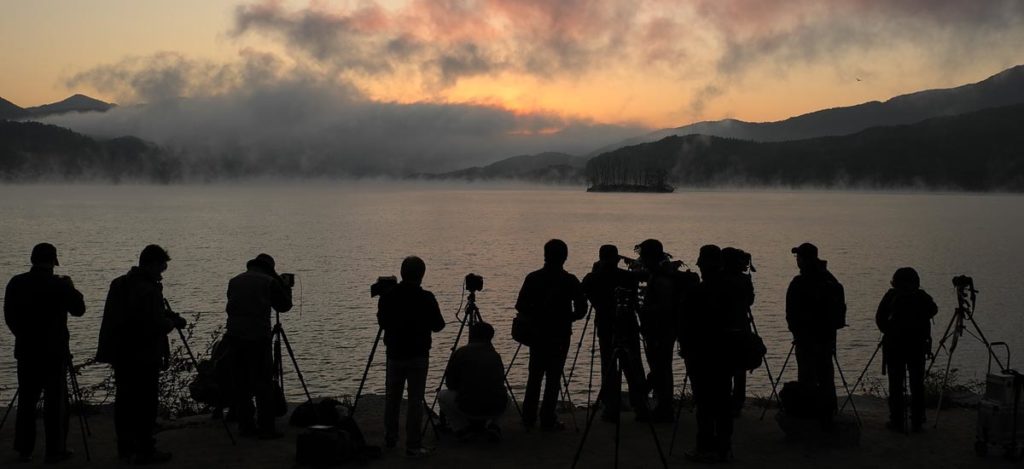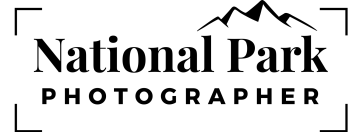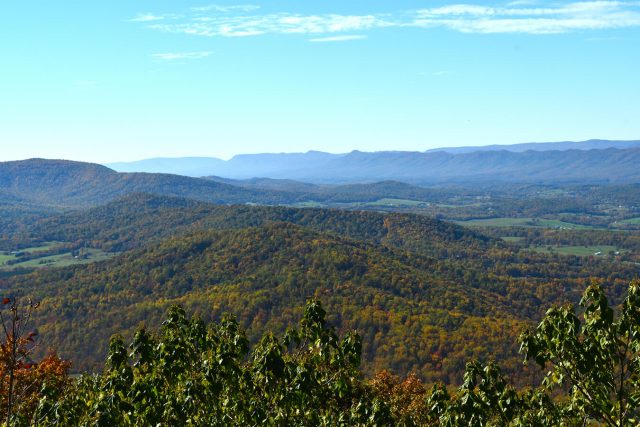
Are you going on a photography day hike and not sure what to bring? This list has our favorite photography, hiking, water, and clothing recommendations. Whether you are hiking for only a small amount of time or a long time, it’s important to be prepared.
Please note, by making purchases through our affiliate links, you are supporting our mission to celebrate and showcase our National Parks and the photographers who frequent them. As an Amazon Associate, National Park Photographer earns from qualifying purchases at no cost to you. We appreciate your support.
Recommended Landscape Photography Gear
While you can photograph any National Park with a cell phone camera (they are getting better every day), if you want professional landscape photography prints, this is the gear that we recommend:
- A high-quality DSLR/Mirrorless camera There are tons of different amazing quality DSLR cameras available, including the new mirrorless ones. I currently use the Canon R5 and LOVE it for landscape photography!
- A sturdy tripod Quality landscape photographs are best made when using a tripod. This allows you to keep your ISO at 100 and your f-stop at an optimal range (usually f 5.6 – f 11) while allowing for a slower shutter speed in low light conditions. Don’t forget accessories like a base plate or L-plate and a tripod ball head to get the most out of your tripod. My favorite tri-pod is from Really Right Stuff.
- A high-quality wide-angle lens I love the Canon RF15-35mm F2.8 L is USM Lens with my full-frame camera. If you have a crop sensor camera then you may want to go down to 10mm to get the wide angle perspective. If you still use the EF lenses with an RF camera, you can get this RF to EF adapter ring to use them with you mirrorless camera.
- A variable ND filter Neutral density filters are most helpful when photographing situations where the light is too bright or where you want to slow down the shutter speed for a slow water effect. I love the Singh Ray filters.
- A polarizer filter Polarizers make a huge difference in landscape photography situations. My Singh Ray polarizer is a combo filter including a variable ND filter.
- A high-quality zoom lens If you want to photograph wildlife or do close-up shots of different landscape elements, then a high-quality zoom lens is a must. I recommend the Canon RF70-200mm F2.8 L is USM Lens for wildlife or far-away detail shots. This was an incredible lens when photographing the C/2023 A3 (Tsuchinshan–ATLAS).
- A high-quality macro lens Macro lenses are crucial for close-detail macro photographs. I recommend the Canon RF100mm F2.8 L Macro is USM Lens.
- Wireless remote shutter release button To minimize camera shake, I always bring a wireless remote shutter release with me along with extra batteries.
- Lens cleaning kit As landscape photography can be dusty, I always carry a lens cleaner, a microfiber cloth, and a small dust removal tool in my bag. Make sure you lens cleaning solution is under 3 oz if flying on a plane.
- Extra batteries and memory cards It is ALWAYS a good idea to carry extra batteries and memory cards. I once ran out of battery juice after hiking 6 hours to the top of Nevada Falls in Yosemite. Never again! Now I always have a spare battery with me. Also, don’t forget a battery charger to keep the battery charged and ready to go.
- Filming & still photography permits Depending upon your level of photography or filming, permits may be required. As of right now, no permits are required for still photography done without models, props, or sets that take place in public spaces. Click here to find out more information about permits.
- Waterproof bag/Cover It is nice to have some sort of water protection with you. I have a light rain cover for my camera backpack that I always keep with me in case the weather changes. For wetter situations, I have a completely waterproof bag that I like to use while kayaking or hiking in a river bed with my camera equipment.
- Allen wrench/Hex key I have needed this on several occasions and wished I had it when I packed light and forgot to transfer it. An Allen wrench is essential if you want to tighten your tripod or quick-release plate to your camera. You can bring multiple sizes or bring the one specific to your camera.
- Backpack A good-quality camera backpack is a must-have on a landscape photography trip. I currently use a streamlined smaller one but am considering upgrading to a Shimoda Design pack to have a little bit more space for snacks, water, and a place for my tripod.
Recommended Hiking Gear & Safety Equipment
While I don’t bring all of these items with me on every hike, for longer ones they would be very useful. Here are some items you might want to bring with you while hiking:
- GPS tracker/Hiking map/Compass Many of the National Parks have little to no cell reception. Because of this, it is essential to have some sort of map or GPS-tracking device to help you navigate the many trails and roads. Even when you don’t think you will get lost if the trails are poorly marked it is a possibility. Some GPS trackers, like the Garmin inReach, can also communicate your location to others. At a minimum, have a printed copy of the maps and hiking trails or download them to your phone.
- Hiking poles I love using lightweight hiking poles while on longer hikes. They help me navigate uneven terrain when I am hiking up or down an incline.
- Moleskin Moleskin is super useful if you feel a blister coming on while hiking. Make sure to have a small set of scissors with you or have it pre-cut.
- First aid kit Even a small first aid kit is helpful to have while hiking. I cannot count the number of times I’ve needed to clean a small scrape and cover it with a bandaid. On one hike, I went with a youth group and one of the girls twisted her knee. Thankfully I had an ace bandage with me and was able to help her wrap it so she could get back down. You can keep a larger first aid kit in your car, but it does no good if you are 5 miles away from it. You can create a small customized first aid kit to fit your needs.
- Fire Source While you can’t always light a fire in undesignated areas, in an emergency, it’s nice to have a source of heat and fuel just in case. A small pack of waterproof matches or a small lighter would be sufficient to carry with you.
- Bear bells/Bear spray/Whistle Not everyone loves the sound of bear bells, but in some National Parks, they are highly recommended, as is bear spray. In other parks, like Glacier National Park, the rangers have told me that a bear bell is akin to announcing “dinner is served” to the bears because they associate the sound with food. The choice is yours. Having bear spray is always a good idea in bear dense parks but you won’t be able to carry it onto an airplane with you. A whistle is also a good idea if you get lost.
- Solar battery pack Having a small, portable, solar battery has been very helpful while on long hikes. If your only map is downloaded to your phone, you will be grateful to have a way to charge it if you are on a long hike or get lost.
- Headlamp/Flashlight It’s important to have a flashlight with you, especially when hiking after sunset or before sunrise. Most cell phones have flashlights built into them but a headlamp will allow you to go hands-free while hiking back to your car.
- Sun protection I can’t count the number of times that I’ve forgotten to bring sunscreen with me and regretted it. When you are hiking, especially out in the open at high elevations, some sort of sun protection is helpful. Sunglasses, sunscreen, or a hat can all help protect you from a painful sunburn.
- Solar blanket/Emergency Bivvy A solar blanket is as small as a pack of cards and can save your life in an emergency. If you are hiking in colder temperatures or for a longer amount of time, then an Emergency Bivvy is even better. At just 3.5 oz in weight and the size of a soda can, it will reflect 90% of your body heat back to you and has a whistle and tinder cord.
- Knife or Multi-tool A knife or multi-tool can come in handy in an emergency and is small and lightweight.
- Insect repellent I will never forget going on the Gumbo Limbo Trail at Everglades National Park and having a swarm of mosquitoes swoop down upon me. I got out of there as fast as I could. As photographers, we tend to make frequent and long stops. Having some sort of insect repellent or net will make your life much more enjoyable.
- Hand sanitizer/wipes It is always good to have a way to clean your hands when you are out hiking in nature.
- Kula cloth or pStyle If I can avoid peeing on a trail, I do. But some hikes are long enough that it is necessary. A reusable Kula cloth or pStyle will make your life easier.
- A hiking companion/Contact information While it’s not always possible to have someone hike with you, at a minimum let your loved ones know where you are and when you plan to return. It is also important to carry some form of identification with you as well as an Emergency contact card.
Recommended Clothing
Here are some items you might want to bring with you while hiking in a National Park:
- Cooling towel/Buff/Bandana Dripping sweat onto your camera body is no fun while hiking. A cooling towel, buff, or bandana can help keep you cool while also allowing you to wipe off sweat as needed. You can wear it around your neck, forehead, or wrist.
- Moisture-wicking and weather-appropriate quick-drying clothes There are far too many clothing options to list them all here. I like using quick-drying pants and shirts while hiking. This was especially useful while kayaking on the ocean in Biscayne National Park. It’s nice dressing in layers. Even in the summer, temperatures can vary at different elevations. I found snow in Bryce Canyon in the early fall and had to layer up at times in the shade only to strip down later to a short-sleeved shirt in the sun. Layers will help you regulate your body temperature and will help you be more comfortable while hiking.
- Lightweight fleece or jacket A lightweight fleece or jacket is very helpful as it will keep you warm and provide a windbreak for you but is still light enough to carry around your waist when the sun comes out.
- Hiking boots/Trail runners/Crampons Good hiking shoes are a must. I once hiked up to Emerald Lake in Rocky Mountain National Park with old tennis shoes and hit several patches of snow even though it was June. Several other hikers had Crampons on and I later found out why. With no good grip, I slipped on an icy ledge with all of my camera gear. Thankfully everything was okay, except my pride, and I was able to continue on my journey. That said, having good shoes with a steady grip will make your life easier. Just be sure to break them in before your trip to avoid blisters and sore feet.
- Hiking socks Just like good shoes are important, the kind of socks you wear are equally important. Many hikers recommend wool socks. As I’m allergic to wool, I prefer to use synthetic running socks. Swiftwick socks are my favorite as they dry quickly and have a contoured compression fit which helps support my feet and prevents blisters.
- Gloves/Beanie/Hand warmers There are several good options for gloves and hats. Even if you are going to a National Park with a warm environment, you will be grateful to have these on hand. When I went to the Haleakala Summit for sunrise, I was shocked that temperatures were in the low 30s. Thankfully I had a beanie, sweatshirt, and running gloves with me. Even with this added protection, we had to get up close and personal with the people next to us to keep warm. The next sunrise I did on Cadillac Mountain in Acadia I learned my lesson and included hand warmers as well. I ended up sharing my gloves and hand warmers with a fellow photographer who was freezing.
- Extra clothes/socks I don’t always carry extra clothes or socks with me as they can be heavy, but I have occasionally found myself in situations where I wished I had some. Especially an extra pair of socks. It’s not fun hiking back to your car with wet socks after having your foot slip into a riverbed by accident. Wet clothes, even from sweat, can also make it difficult to stay warm in cold situations. If you have the space, it’s a good idea.
Recommended Food and Water
Here are some food and water recommendations you might want to consider while hiking:
- Refillable water bottle/CamelBak The American Hiking Society recommends drinking 1/2-1 qt (.5-.9 l) of water for every hour you are hiking. For more intense hikes, you may need even more water. Having enough water readily available is key to staying hydrated. One tip I learned from a fellow hiker is to take a small sip of water and then swish it around your mouth for several seconds before swallowing. This helps extend your water and helps you feel satiated. Rotating water with a sports drink is also helpful to prevent dehydration. Drink before you feel thirsty and drink often.
- Water filtration tablets/Life Straw I can’t emphasize this point enough. When I hiked to the top of Yosemite Falls, I thought that we had packed enough water. Sadly, I got separated from my son as he was a faster hiker than me. By the time I got to the top of the falls, I was parched and in dire need of water. There was none left as he drank all of it. On my way back down, I saw a mountain stream and was so thirsty that I almost drank from it. But I knew that there had been outbreaks of the Hantavirus in Yosemite and so I chose to keep hiking. Thankfully, four hikers had a large water bladder that they were carrying and offered to give me a cup of water. It was enough to get me to the bottom of the hike. If I had had a Life Straw or water purification tablets with me, then I could have averted the dire situation.
- Trail Snacks Even on small hikes, I have always been grateful for trail snacks. They can help regulate your electrolytes and keep you from becoming dehydrated. Energy bars, granola bars, beef jerky, and fruit snacks are some of my favorite lightweight trail snacks. I also love all kinds of trail mix. Keep your snacks easily accessible.
- Breakfast/Lunch/Dinner On longer hikes, it helps to bring a meal with you, especially when you are waiting for the sun to rise or set. I like packing a sandwich along with my trail snacks. Freeze-dried meals are also good as they are lightweight and calorie-dense.
- Jetboil/Fuel source My first time using a Jetboil was when I went up to Glacier Point in Yosemite National Park to do some astrophotography. We brought some hot chocolate packets with us and were able to heat our water quickly for a warm drink. The Jetboil is small, lightweight, and pairs nicely with freeze-dried meals and drink mixes.
- Extra food Pack what you think you will need, and then pack extra. You never know if you will need to share with someone else or if you will need it in an emergency. When I photographed Racetrack Playa in Death Valley National Park, our car broke down 27 miles off-road in the dead of summer. We didn’t have enough food with us. Thankfully we were able to get our car started again and made it out of the desert, but I will never go empty-handed again.
- Extra water Extra water is also important and can be life-saving. If you know you will have a nearby water source on your hike, then at minimum bring a way to purify it.
- Trash bag Sometimes we forget this small detail, but when hiking in nature, you need to pack out what you bring in. A small trash bag will make this easier. I also like to have some Ziplock bags with me in case I need to seal anything.


